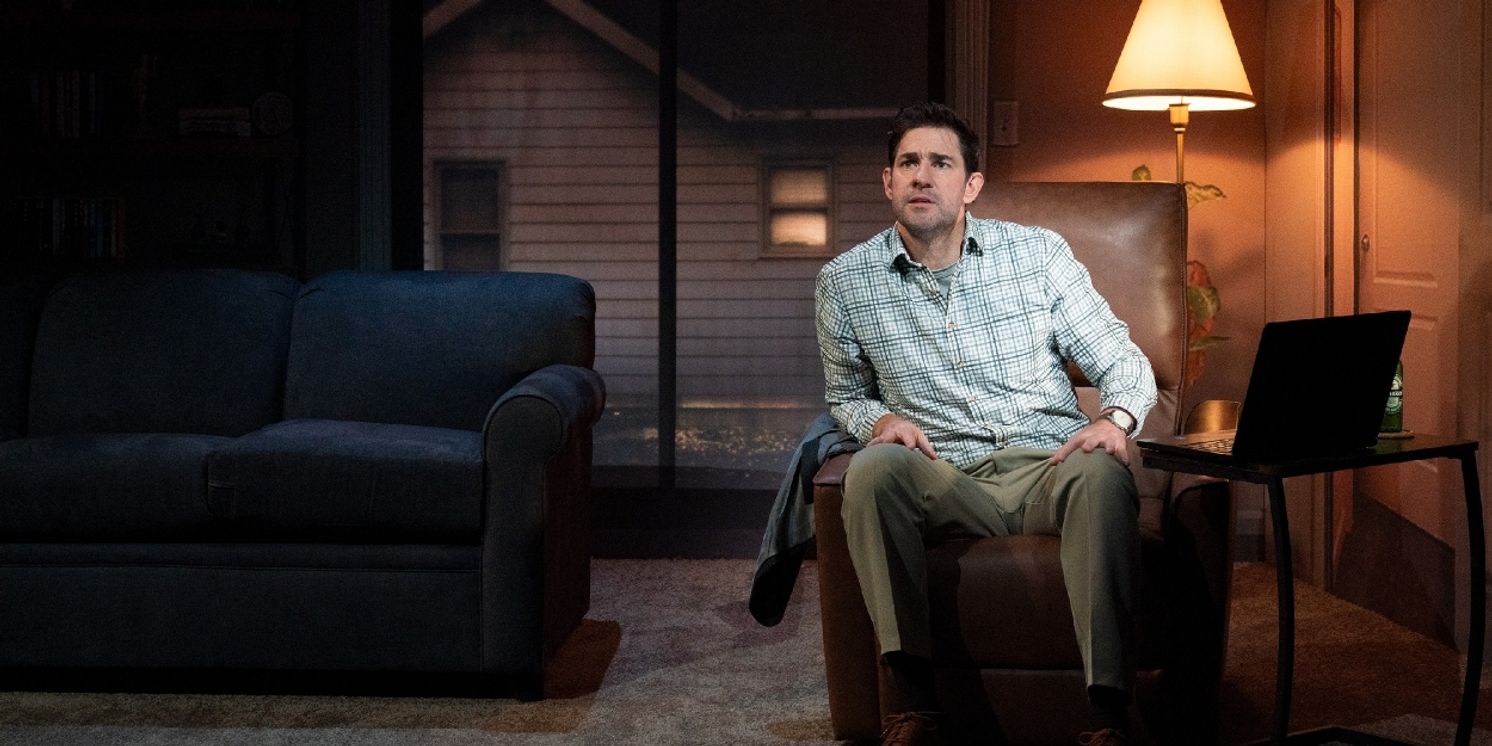Review Roundup: John Krasinski in ANGRY ALAN
This inaugural production at Studio Seaview plays through August 3.

Performances are now underway for John Krasinski in Penelope Skinner’s ANGRY ALAN, directed by Sam Gold. This inaugural production at Studio Seaview plays through August 3.
Roger is divorced, demoted, and drifting—lost in an era that no longer makes sense. But when an online personality promises clarity, Roger dives in without looking back. Timely, provocative, and darkly comedic, Angry Alan explores one man’s journey down the digital rabbit hole—examining how far he's willing to go, and how much he's prepared to lose, for validation in a world where “everybody’s changing the rules.
ANGRY ALAN features scenic design by Tony Award nominee dots, costume design by Qween Jean, lighting design by Tony Award nominee Isabella Byrd, sound design by Tony Award nominee Mikaal Sulaiman, video design by Tony Award nominee Lucy Mackinnon, properties by Addison Heeren, with Niamh Jones as associate director, Kate Wilson as vocal coach, and dramaturgy by Sarah Lunnie. Production stage manager is John C. Moore, with production supervision by Hudson Theatrical Associates / Sean Gorski and Seaview / Jonathan Whitton serving as general manager. Casting by Taylor Williams, CSA.
Read the reviews below!
 Johnny Oleksinski, New York Post: Krasiniski is a much more commanding stage performer than I ever thought he’d be, and he capably freight-trains through his almost-monologue while never sacrificing nuance or beats of the story. Gold, who theatergoers tend to associate with pregnant pauses, does just as well with Skinner’s gap-free dash as he does with Annie Baker’s pot-head grazes.
Johnny Oleksinski, New York Post: Krasiniski is a much more commanding stage performer than I ever thought he’d be, and he capably freight-trains through his almost-monologue while never sacrificing nuance or beats of the story. Gold, who theatergoers tend to associate with pregnant pauses, does just as well with Skinner’s gap-free dash as he does with Annie Baker’s pot-head grazes.
 Lane Williamson, Exeunt: Krasinski’s casting (by Taylor Williams) is key to the play’s success. Krasinski exudes nice-guy energy, the kind of lovable, dopey presence that made him stand out on The Office. He’s unbelievably handsome, but his face also kind of looks like a stuffed bear. There’s a pervasive gentleness, a comforting vibe which is then upended, quite dramatically, as he spirals out of control. Roger’s unraveling veers from light comedy to boiling anger to terrifying anguish and Krasinski effortlessly navigates that terrain. With his face lit primarily by a computer screen as he plunges into the abyss, the play’s final seconds are bone-chilling.
Lane Williamson, Exeunt: Krasinski’s casting (by Taylor Williams) is key to the play’s success. Krasinski exudes nice-guy energy, the kind of lovable, dopey presence that made him stand out on The Office. He’s unbelievably handsome, but his face also kind of looks like a stuffed bear. There’s a pervasive gentleness, a comforting vibe which is then upended, quite dramatically, as he spirals out of control. Roger’s unraveling veers from light comedy to boiling anger to terrifying anguish and Krasinski effortlessly navigates that terrain. With his face lit primarily by a computer screen as he plunges into the abyss, the play’s final seconds are bone-chilling.
 Robert Hofler, The Wrap : Roger is angry, but as cunningly played by Krasinski, he is also kinda sweet, which is why, I think, the laughter from the men in the audience may be far less pointed in its attack. Krasinski expertly dons lamb’s clothing to play a man who’s basically a pig. Krasinski is also very effective at playing all the people in Roger’s life. He makes us want to go to the ‘Angry Alan’ website, to which Roger has become addicted and to which he even donates one month of child support.
Robert Hofler, The Wrap : Roger is angry, but as cunningly played by Krasinski, he is also kinda sweet, which is why, I think, the laughter from the men in the audience may be far less pointed in its attack. Krasinski expertly dons lamb’s clothing to play a man who’s basically a pig. Krasinski is also very effective at playing all the people in Roger’s life. He makes us want to go to the ‘Angry Alan’ website, to which Roger has become addicted and to which he even donates one month of child support.
 Dan Rubins, Slant: We learn all this from Roger in a lightning-speed monologue, staged smoothly and playfully by Sam Gold and delivered by Krasinski with jovial, almost folksy charm. And Skinner breaks down Roger’s increasingly appalling ideas into small enough leaps of logic that we sometimes don’t realize how far from reality he’s traveled until he’s already too far gone
Dan Rubins, Slant: We learn all this from Roger in a lightning-speed monologue, staged smoothly and playfully by Sam Gold and delivered by Krasinski with jovial, almost folksy charm. And Skinner breaks down Roger’s increasingly appalling ideas into small enough leaps of logic that we sometimes don’t realize how far from reality he’s traveled until he’s already too far gone
 Jesse Green, New York Times: Though Skinner never writes less than compellingly, and Krasinski is willing and able to go where she takes him, I wasn’t. Whether we are being asked to sympathize with Roger as a victim (doubtful) or to consider our own vulnerability to his brand of charming awfulness (no thanks), I could fathom no reason, beyond the intelligence of the performance and production, to spend 85 minutes with him. We already live with him 24/7.
Jesse Green, New York Times: Though Skinner never writes less than compellingly, and Krasinski is willing and able to go where she takes him, I wasn’t. Whether we are being asked to sympathize with Roger as a victim (doubtful) or to consider our own vulnerability to his brand of charming awfulness (no thanks), I could fathom no reason, beyond the intelligence of the performance and production, to spend 85 minutes with him. We already live with him 24/7.
 Elysa Gardner, New York Sun: The playwright has an ideal messenger in Mr. Krasinski, who delivers a slow-building performance that’s ultimately as haunting as it is hilarious. Directed by Sam Gold — who wisely wields a lighter hand here than he has in various reinterpretations of Shakespeare and other classics — the actor finds humor in his character’s cluelessness and self-pity, sustaining a breezy, ironically cheerful vibe through much of the production.
Elysa Gardner, New York Sun: The playwright has an ideal messenger in Mr. Krasinski, who delivers a slow-building performance that’s ultimately as haunting as it is hilarious. Directed by Sam Gold — who wisely wields a lighter hand here than he has in various reinterpretations of Shakespeare and other classics — the actor finds humor in his character’s cluelessness and self-pity, sustaining a breezy, ironically cheerful vibe through much of the production.
 Frank Scheck, New York Stage Review: The play, originally presented at the 2018 Edinburgh Festival Fringe, skewers and satirizes the ideas that Roger is parroting, and the manner in which he absorbed them, with copious amounts of humor. Most cannily, Skinner makes Roger sympathetic, even likable, rather than obviously loathsome. The casting of Krasinski is a masterstroke, with the actor’s inherent charm and warm appeal fascinatingly contrasting with the frequently loathsome ideas his character is expressing. Addressing us in the same folky, self-deprecating manner as he did playing Jim Halpert in The Office, the actor instantly has the audience on his side, providing an uncomfortable tension to the proceedings.
Frank Scheck, New York Stage Review: The play, originally presented at the 2018 Edinburgh Festival Fringe, skewers and satirizes the ideas that Roger is parroting, and the manner in which he absorbed them, with copious amounts of humor. Most cannily, Skinner makes Roger sympathetic, even likable, rather than obviously loathsome. The casting of Krasinski is a masterstroke, with the actor’s inherent charm and warm appeal fascinatingly contrasting with the frequently loathsome ideas his character is expressing. Addressing us in the same folky, self-deprecating manner as he did playing Jim Halpert in The Office, the actor instantly has the audience on his side, providing an uncomfortable tension to the proceedings.
 Michael Sommers, New York Stage Review: Crafted by British author Penelope Skinner (with a credit to Don Mackay, an actor who created the role of Roger in the play’s 2018 premiere at the Edinburgh Festival), Angry Alan is a character study and not a shocker. It paints in abundant detail an oddly poignant picture of an average-type white guy hanging on the cusp of MAGA times, disappointed by his life, who embraces a radical mindset. Ironically funny as Roger tries to explain and justify Alan’s way of thinking, scary possibilities flicker through his narrative. How tragic will it be? A confrontation proves more subdued than sensational. It is impossible to evaluate the content further without revealing a surprise the production takes care to guard.
Michael Sommers, New York Stage Review: Crafted by British author Penelope Skinner (with a credit to Don Mackay, an actor who created the role of Roger in the play’s 2018 premiere at the Edinburgh Festival), Angry Alan is a character study and not a shocker. It paints in abundant detail an oddly poignant picture of an average-type white guy hanging on the cusp of MAGA times, disappointed by his life, who embraces a radical mindset. Ironically funny as Roger tries to explain and justify Alan’s way of thinking, scary possibilities flicker through his narrative. How tragic will it be? A confrontation proves more subdued than sensational. It is impossible to evaluate the content further without revealing a surprise the production takes care to guard.
 Adrian Horton, The Guardian: But the play’s main draw in the manosphere-dominant year of 2025 is Krasinski, who ultimately delivers a masterful performance that not only conveys Roger’s loneliness and delusion but the confusion, bewilderment and hurt of the women around him. That the rushed ending, with a late-stage twist, is as effective as it is owes to his body near vibrating with currents of shame, confusion, hate and, yes, anger. It’s a fascinating use of the everyman quality, turning our sympathy to someone who espouses misogyny, playing into aspects of traditional masculinity while evincing its traps, framing red-pill ideology as poison and straight men’s feelings as prey. One could contest the framing, but I can’t begrudge empathy, nor the potential that Jim Halpert might give some unsuspecting boyfriends a surprise warning.
Adrian Horton, The Guardian: But the play’s main draw in the manosphere-dominant year of 2025 is Krasinski, who ultimately delivers a masterful performance that not only conveys Roger’s loneliness and delusion but the confusion, bewilderment and hurt of the women around him. That the rushed ending, with a late-stage twist, is as effective as it is owes to his body near vibrating with currents of shame, confusion, hate and, yes, anger. It’s a fascinating use of the everyman quality, turning our sympathy to someone who espouses misogyny, playing into aspects of traditional masculinity while evincing its traps, framing red-pill ideology as poison and straight men’s feelings as prey. One could contest the framing, but I can’t begrudge empathy, nor the potential that Jim Halpert might give some unsuspecting boyfriends a surprise warning.

Average Rating: 77.8%
- To read more reviews, click here!
- Discuss the show on the BroadwayWorld Forum
Reader Reviews

|
Powered by
|
Videos



